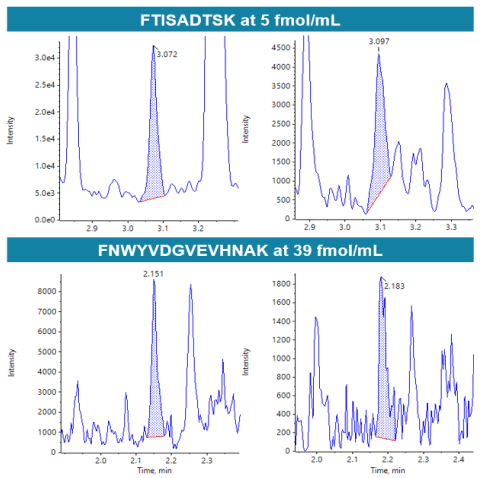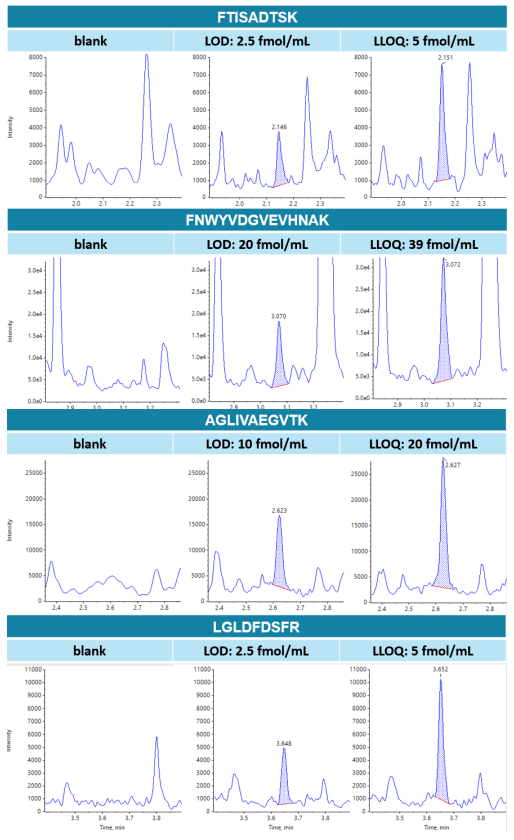Abstract
Here, a SCIEX Triple Quad™ 7500 LC-MS/MS System was used to quantify surrogate peptides for a therapeutic antibody in rat plasma. Multiple MS improvements significantly enhanced the system sensitivity. Ultra-low LLOQs, ranging from 5 to 39 fmol/mL were achieved with high reproducibility, precision, accuracy, and linearity.
Introduction
Quantification of peptide/protein therapeutics in biological matrices is crucial for therapeutic development. Serving as an orthogonal technology to the traditional ligand binding assays (LBAs), LC-MS has been routinely adopted for quantitative measurement of protein levels in bioanalytical laboratories. The capability of a triple quadrupole system to quantify low concentration analytes from small sample volumes, in line with current LBAs, has been a main stay of analytical analysis in this area. However, further sensitivity, improved %CV and linear dynamic range (LDR) operating down to lower concentrations would greatly benefit this analytical methodology.
While different MS approaches have been investigated by researchers, quantification using peptides as surrogates (bottomup proteomic workflows) using targeted LC-MRM strategies remains the most common. It offers not only high sensitivity, but also a wide linear dynamic range (LDR) combined with high reproducibility to provide reliable quantitative measurements.
Here, a SCIEX 7500 System was used to quantify a series of surrogate peptides in rat plasma. Multiple hardware improvements on the ion source and the front end of the mass analyzer significantly boost the systems sensitivity and low-level %CV values. Ultra-low LLOQs, ranging from 5 to 39 fmol/mL are achieved. The assay shows high reproducibility, precision, accuracy, and linearity, proving the robustness and performance of the developed method.

Key features of peptide quantification workflows
- Hardware improvements on the SCIEX 7500 System provide significant gains in sensitivity for peptide quantification: the OptiFlow® Pro Ion Source with E Lens™ Technology provides improvements in ion generation and the D Jet™ Ion Guide improves ion sampling1
- An average of 3-fold improvement in S/N was observed when analyzing surrogate peptides in biological matrices with high reproducibility, accuracy, and linearity
- SCIEX OS Software—an easy to use, compliance ready and single platform for acquisition, processing and data management
Methods
Sample preparation: Plasma proteins were precipitated with cold methanol. Upon centrifugation, supernatant was discarded. The pellet was solubilized in 200 mM ammonium bicarbonate in 10/90 (v/v) methanol/water. Digestion was performed using trypsin. After one hour at 60°C, the solution was acidified by adding formic acid.1 The digested plasma was diluted by 200x using 5 : 1 : 94 (v/v/v) acetonitrile/formic acid/water. Synthesized peptides (Table 1) were spiked into the digested plasma solution and followed by serial dilution in matrix. Final injection volume was 10 µL.
Signature peptide quantification
The SCIEX 7500 System integrates innovations that provide improvements in both ion generation and ion sampling. The OptiFlow Pro Ion Source with E Lens Technology provides improvement in ion generation and the D Jet Ion Guide efficiently captures and transmits the ions in the high gas flow behind the orifice plate.
To identify the sensitivity improvements provided by these innovations, the same peptide sample sets were analyzed on both the SCIEX 7500 System and the SCIEX 6500+ System. On average, a 6-fold difference in peak area and a 3-fold difference in S/N were observed (Figure 1).
The peptide serial dilution samples were injected onto a SCIEX 7500 System to evaluate the overall quantification performance. As shown in Figures 2, 3 and 4, the LLOQs of the target peptides range from 5 to 40 fmol/mL, with LDR up to 4 orders of magnitude without internal standard normalization. For all quantified samples, the %CV was within 10% and the accuracy was within 94-106%.

Conclusion
- A highly sensitive peptide quantification workflow using the SCIEX Triple Quad 7500 LC-MS/MS System – QTRAP Ready has been developed
- When combining the OptiFlow Pro Ion Source with E Lens Technology and D Jet Ion Guide, an average 3-fold improvement in sensitivity over the previous generation of instrumentation was observed when quantifying surrogate peptides in biological matrix
References
- Enabling new levels of quantification. SCIEX technical note RUO-MKT-02-11886-A.
- Ouyang Z. et al. (2012) Bioanalysis 4(1): 17-28.





